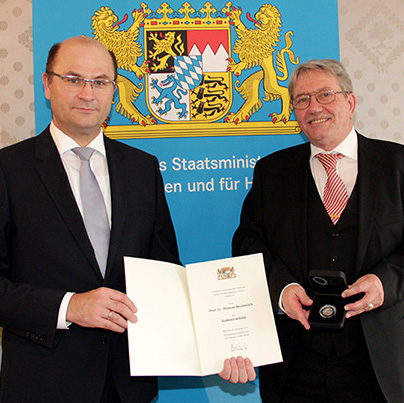Verleihung des Karl Rinner Preises 2018
Die Verleihung des Karl Rinner Preises 2018 an Dr. Andreas Hellerschmied fand am 22. Oktober 2019 im Rahmen einer öffentlichen Festsitzung der Österreichischen Geodätischen Kommission im Ferdinand Eidherr Saal des Bundesamtes für Eich- und Vermessungswesen, Wien, statt.
Nach der von Univ.Prof. Böhm gehaltenen Laudatio wurde die Karl Rinner Preis Urkunde vom Präsidenten der ÖGK, Univ.Prof. Pfeifer und der von der ZT: Bundeskammer der ZiviltechnikerInnen/ Bundesfachgruppe Vermessungswesen gesponserte Preisscheck von DI Christian Lidl überreicht.
Im Anschluss an die Preisverleihung hielt Dr. Hellerschmied seinen Festvortrag zum Thema: Satelliten-Tracking mit VLBI. Diese Arbeit wurde von Dr. Hellerschmied während seiner Tätigkeit an der TU Wien erstellt. Derzeit ist Dr. Hellerschmied beim BEV in der Abteilung Grundlagen beschäftigt.
Zum Download:
- Curriculum Vitae
- Ausgezeichnete Publikation: Hellerschmied et al. (2018) – Observing APOD with the AuScope VLBI Array
- Präsentation Festvortrag
- Publikation in der Österreichische Zeitschrift für Vermessung und Geoinformation (VGI)
Zusammenfassung der ausgezeichneten Publikation:
Observing APOD with the AuScope VLBI Array
Abstract: The possibility to observe satellites with the geodetic Very Long Baseline Interferometry (VLBI) technique is vividly discussed in the geodetic community, particularly with regard to future co-location satellite missions. The Chinese APOD-A nano satellite can be considered as a first prototype—suitable for practical observation tests—combining the techniques Satellite Laser Ranging (SLR), Global Navigation Satellite Systems (GNSS) and VLBI on a single platform in a Low Earth Orbit (LEO). Unfortunately, it has hardly been observed by VLBI, so major studies towards actual frame ties could not be performed. The main reason for the lack of observations was that VLBI observations of satellites are non-standard, and suitable observing strategies were not in place for this mission. This work now presents the first serious attempt to observe the satellite with a VLBI network over multiple passes. We introduce a series of experiments with the AuScope geodetic VLBI array which were carried out in November 2016, and describe all steps integrated in the established process chain: the experiment design and observation planning, the antenna tracking and control scheme, correlation and derivation of baseline-delays, and the data analysis yielding delay residuals on the level of 10 ns. The developed procedure chain can now serve as reference for future experiments, hopefully enabling the global VLBI network to be prepared for the next co-location satellite mission.













